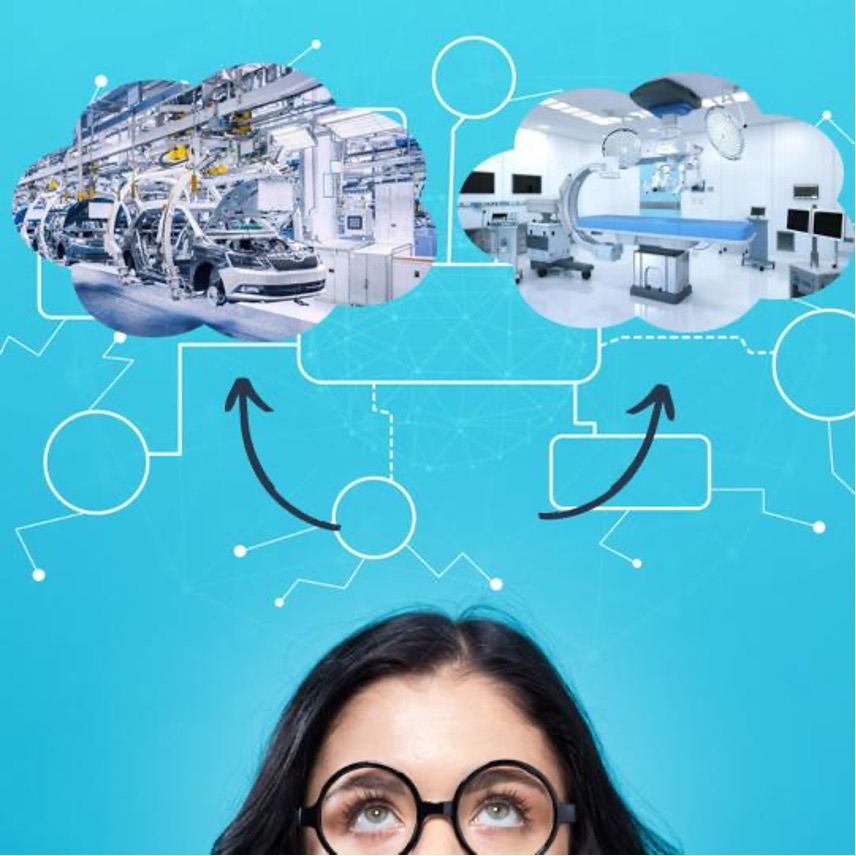- Home
- Resource Center
- Articles & Videos
- Cross-Industry Learning: AI Insights and Lessons from Localization
25 March 2024
| by Globalization and Localization Association
Cross-Industry Learning: AI Insights and Lessons from Localization

Cross-industry learning, based on identifying technology, processes, and human expertise that can be transferred from one sector to another, has proven beneficial to many commercial endeavors. Exploring markets outside one’s own can yield significant advantages, providing a platform for competitive edge, cost reduction, risk mitigation, and future innovation. For example, engineering and automation ideas from the automotive industry have had a profound impact on healthcare robotics, leading to the development of advanced robotic-assisted surgery systems. Similarly, corporate training has embraced gaming technologies, following the gaming industry's lead in terms of engagement and skill development.
For instance, in recent years, challenges such as the pandemic have prompted businesses to be more inventive in engaging and upskilling employees. Developments such as AI require that business be agile and accommodate the influx of new generations of employees by leveraging digital tools and modes of learning they are already familiar with. Thus, game-based training, increasingly leveraging virtual reality technology, provides immersive and collaborative learning experience that foster stronger work relationships in an engaging and a risk-free environment.
One well-cited example is that of how the global retailer IKEA employs VR gamification to enhance online shopping for customers, while also streamlining training for employees. Immersive VR experiences provide customers with an opportunity to fully visualize potential purchases. It also supports employee training in learning about the company's values and goals, ensuring they are imbued more successfully.
So, as we embark on 2024, what global organization is not weighing up their alternatives when it comes to AI adoption and deployment? Still, given the importance of global business and the wider societal impact of AI, it makes perfect sense to look at and leverage (pun intended) lessons from other industries. To that end, businesses of all kinds could do no worse than to study the language and translation sector, known professionally as Localization.
A seasoned pioneer, the sector is increasingly harnessing the potential of AI and is continually redefining its landscape and revolutionizing processes. The intricacies of language, cultural nuances, and the imperative of global communication and commerce have driven this sector to the forefront of AI usage, developing AI technology, integrating AI to create workflow efficiencies, creating commercial offerings, providing consultancy, and, crucially, upskilling its professional workforce.
Localization is an example of how the adoption of technology can revolutionize processes and serve as the tipping point for an ongoing synergy of technology and human subject expertise, which is at the heart of much of the concern about AI and potential job displacement.
So why is this important?
First of all, regardless of AI, the Localization industry is critical to our economies because it enables firms to compete globally by addressing a wide range of linguistic issues.
- It ensures that information is culturally appropriate for international markets, thus increasing consumer appeal and sales.
- It helps global brands meet regulatory and legal obligations while doing business on a global scale, ensuring that products and operations comply with local laws and standards.
- It builds trust and global consumer engagement by supporting customer care in local languages and time zones, and it also contributes to increased client purchases and loyalty by connecting with them in their native languages.
- It achieves all of this at scale, seamlessly, and sustainably because it has long since blended the best of human SMEs with ultra-high levels of automation and linguistic AI to boost productivity whilst safeguarding quality.
Is the journey completed? Of course not, but there are things worth observing and noting.
Vital things such as…
Importantly, the language problem is one of the oldest AI problems studied, dating back to the 1950s, and with the advent of Large Language Models, most notably with the release of Chat GPT, we are seeing a resurgence in the Natural Language Processing branch of AI.
So, we seem to have come full circle, and with over 70 years of research, deployments, and lessons learned, there is much to be gained by reviewing the progress of the language industry.
Language service providers (LSPs), the commercial players in the localization sector, have been streamlining their production and workflow technology processes for over three decades, making them available to their translator workforce, and then passing the commercial benefits on to their clients. As a result, the industry as a whole has reached a high level of automation, making it more appealing to outside investment.
In the localization industry, translators enhance individual performance using Computer-Assisted Translation (CAT) tools. Features like Translation Memory (TM) store and suggest previously translated and approved segments. Thus, these tools prove crucial for boosting productivity, ensuring accuracy, and maintaining consistency.
CAT tools are integrated with advanced Translation Management System (TMS) technologies, offering enhanced automation for all stakeholders involved in the localization workflow, including localization buyers. They are robust and capable of handling content throughout its life cycle, providing scalability, control, and transparency for translation assignments.
Translation assignments are not only created, assigned, monitored, and completed within a TMS system, but we now also witness an increase in the volume and quality of data and analytics collected to ensure transparency, quality, and prompt delivery to consumers. Importantly, this data on quality and performance is being collected and used to inform future business decisions and enhance the functionality of new and rapidly evolving linguistic AI capabilities.
Over the past decade, the industry has incorporated increasing amounts of AI, with automation being strengthened with AI-driven solutions (mainly Machine Translation Technology) which have permeated much of the industry and gained varying degrees of support from clients and suppliers alike due to the improved quality of MT technology. However, depending on the language, content, and individual preferences, absolute acceptance is by no means the case. It is worth emphasizing here that many other industries will also need to properly onboard their professionals, perhaps following a similar path to the localization industry.
New technology requires new skills set
As well as helping the translation process with AI-powered machine translation technology, additional AI capabilities now allow stakeholders to access information about content before it goes into production.
This insight provides significant information about the subject matter of the text, the best technology to use (potentially machine translation or not), and the translator with the strongest skillset for the job. All of this is done before the job goes into production, and deadlines must be respected. Early decision-making, supported by linguistic AI, reduces the time-wasting of limited SME translators and domain SMEs needed in specialzed domains like legal and medical translation assignments. It also obviously saves money on costly corrective action that jeopardizes deadlines.
This evolution? has taken time and has been openly debated by the well-informed, engaged, and vocal community of professionals that make up the localization community.
A growing discourse
The translation profession has a strong foundation thanks to universities and professional associations across the globe. Numerous respected and well-known organizations are also present, highlighting and debating industry news, trends, and job opportunities —but most significantly, actively engaging in the AI discussion. Given the societal and ethical concerns around the increased use of AI, such a broad conversation should be seen as healthy for the sector and an example to other industries.
This extensive conversation has led to the realization that additional training is necessary. While some major LSPs offer training for some AI jobs, such as post-editing machine translation, it is increasingly coming from industry organizations and academic institutions. Perhaps most heartening is the level of agency in the industry from its key translator professionals who are increasingly producing and sharing training material online, despite often being time-strapped. They do this often for free and completely out of their own willingness and desire to share knowledge with their community.
I have worked in this field for 25 years, and the most recent AI renaissance will probably affect all global sectors. As such, other industries would do well to cast an eye over the evolution of the localization industry, particularly with regard to customer service and the empowerment of key professionals.
To date, the localization industry's use of AI technology has helped anticipate challenges, increase human productivity, integrate expert knowledge, provide accountability for quality and a mechanism for improvement, create transparency for all stakeholders, and—most importantly—facilitate exponentially greater levels of human collaboration.
Borrowing from the localization playbook
Naturally, the localization industry is aware of its competitive edge and is not going to get complacent. In reality, it is hard at work analyzing and refining its internal operations and commercial offerings to steadily develop a human-led AI ecosystem that can best serve its customers in the age of AI.
Localization, it turns out, is many things: a career and a way to be recognized for academic and professional achievements; an industry to invest in; an incubator of globally influential ideas, a paradigm of how professionals with the right technology and knowledge can coexist; but perhaps also - most importantly - it is a thought leader in our increasingly AI-based economies and societies.
Regardless of their industry, businesses are facing a multitude of AI opportunities and imminent AI decisions, putting them at a crossroads. With this in mind, they could do no worse than to borrow a page from the localization playbook. As such, they should prioritize the task of developing a skilled and knowledgeable workforce with AI skills as a predictor of future success. This is undoubtedly the main factor contributing to the industry's success thus far and will likely be its most important value proposition in the future.
Do you want to contribute with an article, a blog post or a webinar?
We’re always on the lookout for informative, useful and well-researched content relative to our industry.

Rodrigo Fuentes Corradi
Rodrigo Fuentes Corradi has 20 plus years of experience in the localization industry including over 15 years in strategic and operational roles in MT. He specializes and provides consultancy in human enablement and operational deployment for the future Linguistic AI paradigm.


